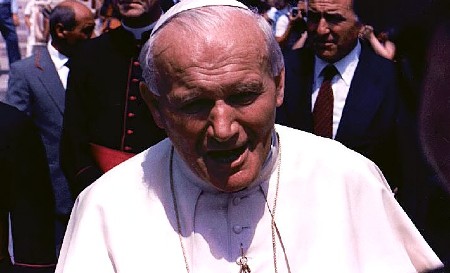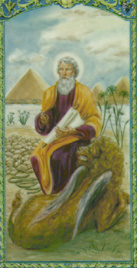Pope St. Linus
FREE Catholic Classes
(Reigned about A.D. 64 or 67 to 76 or 79).
All the ancient records of the Roman bishops which have been handed down to us by St. Irenaeus, Julius Africanus, St. Hippolytus, Eusebius, also the Liberian catalogue of 354, place the name of Linus directly after that of the Prince of the Apostles, St. Peter. These records are traced back to a list of the Roman bishops which existed in the time of Pope Eleutherus (about 174-189), when Irenaeus wrote his book "Adversus haereses". As opposed to this testimony, we cannot accept as more reliable Tertullian's assertion, which unquestionably places St. Clement (De praescriptione, xxii) after the Apostle Peter, as was also done later by other Latin scholars (Jerome, "De vir. ill.", xv). The Roman list in Irenaeus has undoubtedly greater claims to historical authority. This author claims that Pope Linus is the Linus mentioned by St. Paul in his II Timothy 4:21. The passage by Irenaeus (Adv. haereses, III, iii, 3) reads:
After the Holy Apostles (Peter and Paul ) had founded and set the Church in order (in Rome ) they gave over the exercise of the episcopal office to Linus. The same Linus is mentioned by St. Paul in his Epistle to Timothy. His successor was Anacletus.We cannot be positive whether this identification of the pope as being the Linus mentioned in II Timothy 4:21, goes back to an ancient and reliable source, or originated later on account of the similarity of the name.
We ask you, humbly: don't scroll away.
Hi readers, it seems you use Catholic Online a lot; that's great! It's a little awkward to ask, but we need your help. If you have already donated, we sincerely thank you. We're not salespeople, but we depend on donations averaging $14.76 and fewer than 1% of readers give. If you donate just $5.00, the price of your coffee, Catholic Online School could keep thriving. Thank you.Help Now >
Linus's term of office, according to the papal lists handed down to us, lasted only twelve years. The Liberian Catalogue shows that it lasted twelve years, four months, and twelve days. The dates given in this catalogue, A.D. 56 until A.D. 67, are incorrect. Perhaps it was on account of these dates that the writers of the fourth century gave their opinion that Linus had held the position of head of the Roman community during the life of the Apostle ; e.g., Rufinus in the preface to his translation of the pseudo-Clementine "Recognitiones". But this hypothesis has no historical foundation. It cannot be doubted that according to the accounts of Irenaeus concerning the Roman Church in the second century, Linus was chosen to be head of the community of Christians in Rome, after the death of the Apostle. For this reason his pontificate dates from the year of the death of the Apostles Peter and Paul, which, however, is not known for certain.
The "Liber Pontificalis" asserts that Linus's home was in Tuscany, and that his father's name was Herculanus; but we cannot discover the origin of this assertion. According to the same work on the popes, Linus is supposed to have issued a decree "in conformity with the ordinance of St. Peter ", that women should have their heads covered in church. Without doubt this decree is apocryphal, and copied by the author of the "Liber Pontificalis" from the first Epistle of St. Paul to the Corinthians (11:5) and arbitrarily attributed to the first successor of the Apostle in Rome. The statement made in the same source, that Linus suffered martyrdom, cannot be proved and is improbable. For between Nero and Domitian there is no mention of any persecution of the Roman Church ; and Irenaeus (1. c., III, iv, 3) from among the early Roman bishops designates only Telesphorus as a glorious martyr.
Finally this book asserts that Linus after his death, was buried in the Vatican beside St. Peter. We do not know whether the author had any decisive reason for this assertion. As St. Peter was certainly buried at the foot of the Vatican Hill, it is quite possible that the earliest bishops of the Roman Church also were interred there. There was nothing in the liturgical tradition of the fourth-century Roman Church to prove this, because it was only at the end of the second century that any special feast of martyrs was instituted and consequently Linus does not appear in the fourth-century lists of the feasts of the Roman saints. According to Torrigio ("Le sacre grotte Vaticane", Viterbo, 1618, 53) when the present confession was constructed in St. Peter's (1615), sarcophagi were found, and among them was one which bore the word Linus. The explanation given by Severano of this discovery ("Memorie delle sette chiese di Roma", Rome, 1630, 120) is that probably these sarcophagi contained the remains of the first Roman bishops, and that the one bearing that inscription was Linus's burial place. This assertion was repeated later on by different writers. But from a manuscript of Torrigio's we see that on the sarcophagus in question there were other letters beside the word Linus, so that they rather belonged to some other name (such as Aquilinus, Anullinus). The place of the discovery of the tomb is a proof that it could not be the tomb of Linus ( De Rossi, "Inscriptiones christianae urbis Romae", II, 23-7).
The feast of St. Linus is now celebrated on 23 September. This is also the date given in the "Liber Pontificalis". An epistle on the martyrdom of the Apostles St. Peter and Paul was at a later period attributed to St. Linus, and supposedly was sent by him to the Eastern Churches. It is apocryphal and of later date than the history of the martyrdom of the two Apostles, by some attributed to Marcellus, which is also apocryphal ("Acta Apostolorum apocrypha", ed. Lipsius and Bonnet, I, ed; Leipzig, 1891, XIV sqq., 1 sqq.).









 Daily Readings for Thursday, April 25, 2024
Daily Readings for Thursday, April 25, 2024 St. Mark: Saint of the Day for Thursday, April 25, 2024
St. Mark: Saint of the Day for Thursday, April 25, 2024 Prayer for Policemen: Prayer of the Day for Thursday, April 25, 2024
Prayer for Policemen: Prayer of the Day for Thursday, April 25, 2024

